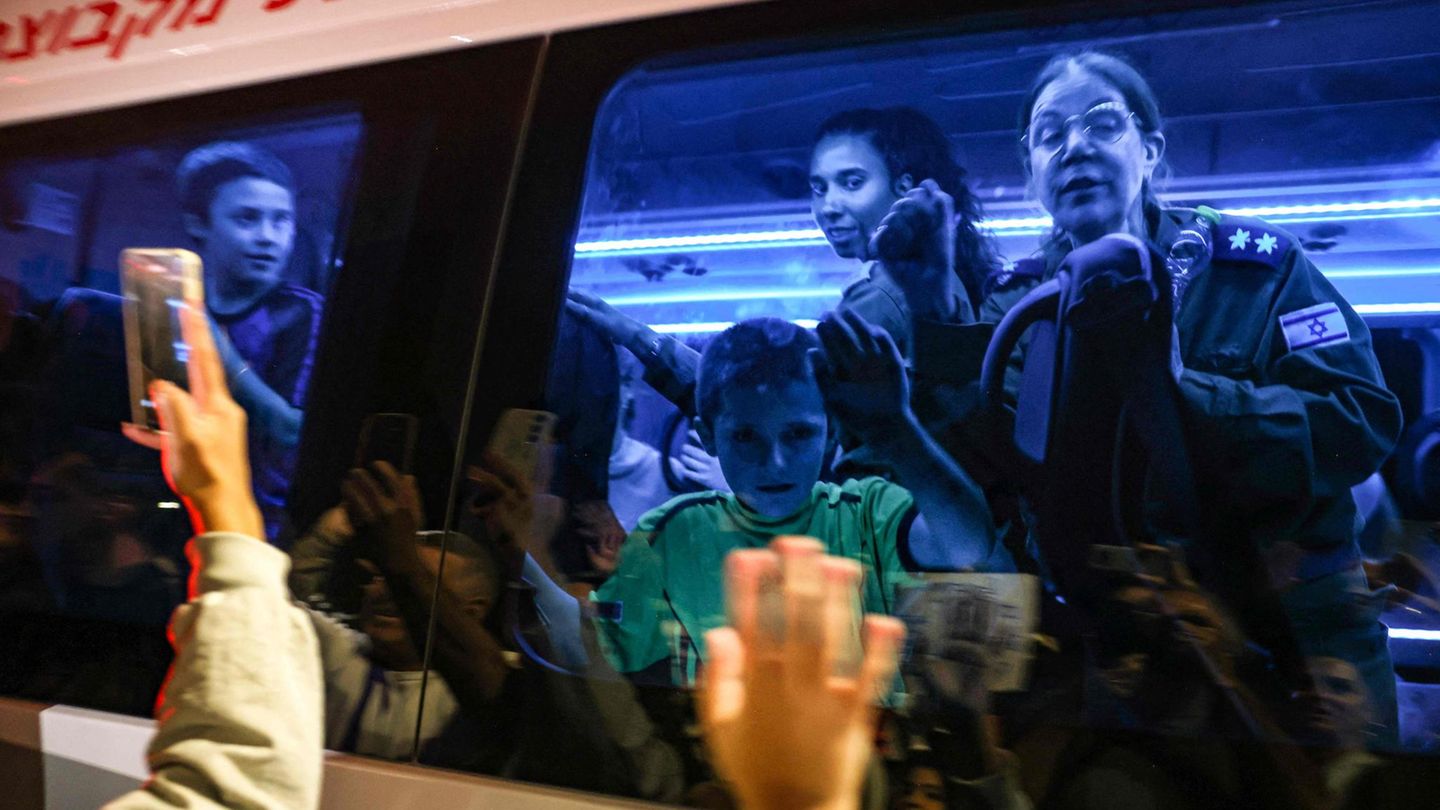After the horrific massacre by the Islamist Hamas in Israel, the worst was also feared for the people kidnapped in the Gaza Strip. The first people released have now told their relatives about their captivity.
Hamas exchanged three groups of hostages for Palestinian prisoners from Israeli prisons during the ceasefire in the war with Israel until Monday morning. Since last Friday, a total of 58 people abducted by the terrorists on October 7th have been released. Those who have returned home are largely shielded from the public; many of them are still in hospitals. Information about where and how they were held is also kept secret. Nevertheless, more and more details about the victims’ weeks-long captivity are leaking out.
Family members of the freedmen in particular reported on the experiences of their relatives. Accordingly, most of the hostages appear to have survived the approximately fifty days in Hamas’s control in at least a stable physical condition. However, the descriptions of their relatives suggest that they all lost weight during their captivity and were sometimes completely cut off from the outside world, as several media reports.
Hamas apparently held hostages underground
“They ate, but not regularly and not all the time,” the Israeli newspaper “Yedioth Achronot” and the “New York Times” quote Merav Raviv, a cousin of Keren Munder (54), who died on Friday with her nine-year-old Son Ohad Munder-Zichri and their 78-year-old mother Ruth Munder were released. “They ate a lot of rice and bread.” On some days there was only pita bread (flatbread), and when that was no longer available either, then The detainees would only have received a small portion of rice.
The cousin reported that people prepared their own meals. “But there were also days when there was nothing to eat.” Keren told her that both she and her mother had lost around six to eight kilograms. The Munders slept in a kind of reception room on improvised benches that they had built from three chairs pushed together. “And sometimes those abducted had to wait an hour and a half before they were allowed to use the toilet.”
Some of the hostages were apparently permanently held underground. According to her nephew Eyal Nouri, 72-year-old Adina Moshe had to “get used to the sunlight” after her release because she hadn’t seen it for weeks. “She was in complete darkness,” Nouri said, according to the Associated Press (AP) news agency. “She walked with her eyes closed because she was in a tunnel. She wasn’t used to daylight. And during her captivity she was […] cut off from the outside world.”
His aunt didn’t know until the last moment that she would be released, says Nouri. “Until she saw the Red Cross. That was the moment she realized, ‘Okay, these terrible seven weeks are over’.”
“She didn’t know dad had been murdered”
Other hostages were also unaware of the events in the outside world. Hannah Katzir, whose husband Rami was murdered and whose son Elad was also kidnapped by Hamas, only found out about the fate of her relatives after they were freed. “As soon as she arrived, she asked, ‘Where is dad?'” Katzir’s daughter Carmit Palti-Katzir told the newspaper Yedioth Achronot. “She didn’t know dad had been murdered. We told her.” Then she wanted to know: “Where is Elad? Why isn’t he here?”. “We told her he was kidnapped.”
Deal between Hamas and Israel
Between fear and relief: This is how the hostages were received on their return
17-year-old Noam Or and his 13-year-old sister Alma, who were released late Saturday, also did not know that their mother, Yonat Or, was murdered in the terrorist attacks until they were released, according to their uncle. “They have some difficult stories to tell about how they were captured and how they were treated,” their uncle Ahal Besorai told the BBC on Sunday. The siblings were taken hostage along with their father Dror, who is believed to still be held in the Gaza Strip, but were held separately. They are currently in a hospital and he has spoken to them via video call.
Yair Rotem, uncle of 12-year-old Hila Rotem-Shoshani, said he had to keep reminding his niece, who was released on Sunday, not to whisper. “They always told them to whisper and be quiet, so I kept telling her that now she can speak louder,” AP quoted the uncle as saying. On her first night back in Israel, Hila slept well and had an appetite.
25-year-old was able to temporarily escape
According to her family, one of the released hostages was able to escape temporarily during her captivity, but was then caught again. There was an explosion in the building where the 25-year-old was being held and the young man was able to escape, his aunt told the Israeli television station Kanal B on Monday. He then wandered around the Gaza Strip for several days trying to escape to get to the border. But Palestinian civilians caught him and handed him back to the terrorists. “He tried to get to the border, but I think because he had no means of understanding where he was, he got into trouble out there.”
The most comprehensive picture to date of conditions in Hamas captivity comes from 85-year-old Yocheved Lipschitz, a hostage who was released before the current ceasefire. Lipschitz said she was held captive in tunnels that stretched under Gaza “like a spider’s web,” according to the Associated Press. The kidnappers “told us that they were people who believed in the Koran and would not harm us.”
The prisoners were treated well and received medical care, including medication, explained Lipschitz. The guards also ensured that they lived in clean conditions. The hostages would have received one meal per day, which consisted of cheese, pickles and flatbread. Her captors would have eaten the same thing.
Sources: , , , DPA
Source: Stern
I have been working in the news industry for over 6 years, first as a reporter and now as an editor. I have covered politics extensively, and my work has appeared in major newspapers and online news outlets around the world. In addition to my writing, I also contribute regularly to 24 Hours World.




